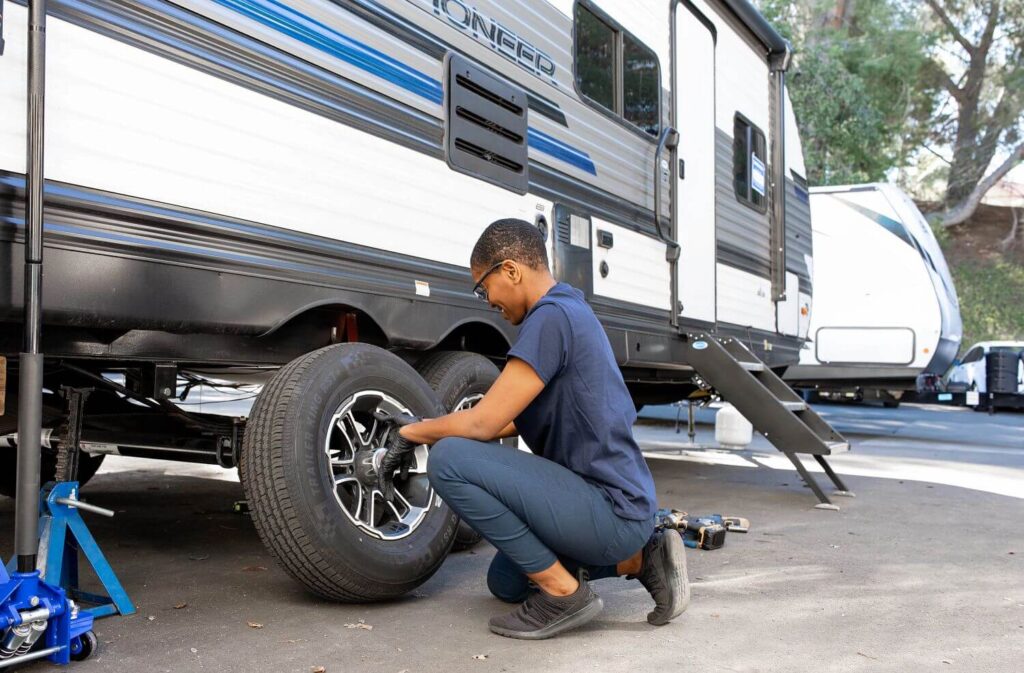Your RV’s tires are its foundation – they must be cared for and protected if you want to enjoy safe, smooth journeys. But tire blowouts are an unfortunate reality of RV life, so it’s good to know how to change a tire on a travel trailer.
We’ll provide tips on tire changes for single and dual-axle travel trailers, but first, a word on how to get help when you’re broken down on the side of the road.
Good Sam Roadside Assistance is designed to help you overcome tire blowouts and other roadside issues. If you’re new to RVing, we highly recommend enrolling in this service, as performing certain emergency services while parked on the side of the road can be highly dangerous. And if you don’t do them correctly, you can do more harm than good.
How to Change a Tire on a Single-Axle Travel Trailer

Photo by Camping World
Technician Tip: At a service center, technicians will use both the frame and the axles as lifting points since they are on flat, level concrete and can access all sizes of jacks. On the side of the road, you’ll likely have a small bottle jack, and there will be no guarantee of the pavement condition (or the ground on the side of the road).
When changing a tire on the roadside, place the jack under the axle as close to the spring mount as possible.
Then follow these steps to change a tire on a single-axle travel trailer:
- Carefully raise the unit slightly so you know it won’t sink or tip, and place wheel chocks on both sides of the tires that remain on the ground.
- Break the lug nuts loose on the tire to be changed.
- Raise the trailer using the jack until daylight is visible under the tire (2-3 inches off the ground).
- Place a jack stand under the axle next to the jack and lower the jack gently until the axle rests upon the jack stand. Verify you can still see daylight under the tire. Jacks are for lifting; jack stands are for working. The jack can be left in place if it isn’t in the way. If you don’t have a jack stand or wheel chock, you could put down your stabilizer jacks only to stabilize the unit (NOT TO LIFT) while your jack is left in place.
- Remove the lug nuts, swap out the tire, and reinstall the lug nuts finger-tight.
- Check the tire pressure in the new tire and adjust as needed.
- Lift the axle with the jack enough to remove the jack stand, then lower it until the tire touches the ground enough that it cannot turn.
- Tighten the lugs in a star pattern in three stages: 20-30 foot-pounds, 50-60 foot-pounds, and then to the final torque recommended by the manufacturer, typically 90-120 foot-pounds.
- Fully retract and remove the jack and chocks.
- Retorque as required by the manufacturer (every 10/25/50 miles or 25/50/100 miles, etc.)
Technician Tip: If you only have one spare tire, we highly recommend proceeding directly to your nearest tire shop to get a replacement for the blown tire. Your spare should be used for emergency purposes only.
Tire Size Description
When calling local tire shops to inquire about spare tire availability, know your rim diameter and tire size to expedite the process. You’ll need a tire matching your existing tire size, which is printed on the tire’s sidewall. It will look something like this: ST225/75R15.
Here’s what those letters and numbers mean:
ST = Special Trailer
225 = Tire width in millimeters
75 = Height-to-width aspect ratio
R = Radial tire
15 = Rim diameter
How to Change a Tire on a Dual-Axle Travel Trailer

Photo by Camping World
For dual-axle trailers, the process of removing the blown tire and installing the spare is essentially the same. The difference lies in your options for raising or jacking up the trailer to remove the blown tire.
Using a Tire Aid is the simplest and quickest method, provided you only have a single blown tire on one side of your trailer. The Tire Aid eliminates the need for a bottle jack to lift your trailer and a jack stand to rest the axle on while changing the tire.
A Tire Aid allows you to drive the remaining good tire onto an elevated cradle so your blown tire is off the ground. Whether you back onto the tire aid or pull forward onto it depends largely on which tire is blown (i.e., pull forward onto it if the rear tire is blown; back onto it if the front tire is blown).
You’ll still need to break the lug nuts loose for the tire you’ll change while it’s on the ground. From there, you can pull up onto the tire aid, which cradles the good tire. It’s still a good idea to place wheel chocks on both sides of one tire on the opposite side of your trailer for added safety.
Then, follow the same procedures to swap out your blown tire for a matching spare:
- Remove the lug nuts, swap out the tire, and reinstall the lug nuts finger-tight.
- Check the tire pressure in the new tire and adjust as needed.
- Pull slowly off the Tire Aid until the replacement tire touches the ground enough that it cannot turn.
- Tighten the lugs in a star pattern in three stages: 20-30 foot-pounds, 50-60 foot-pounds, and then to the final torque recommended by the manufacturer, typically 90-120 foot-pounds.
- Pull completely off the Tire Aid.
- Retorque as required by the manufacturer (i.e., 10/25/50 miles or 25/50/100 miles, etc.)
Once again, it’s smart to acquire a new tire as soon as possible so your spare can return to being what it’s designed for – an emergency option.
Here are a few more resources to help you care for your RV’s tires:
- How to Maintain Your RV Tires While in Storage
- Everything You Need to Know About RV and Trailer Tires
- Do You Need an RV Tire Pressure Monitoring System?
Do you have any tips or tricks for changing a tire on an RV? Share them with your fellow RVers in the comments below.
The post How to Change a Tire on a Travel Trailer appeared first on Camping World Blog.
By: Tucker Ballister
Title: How to Change a Tire on a Travel Trailer
Sourced From: blog.campingworld.com/learn-to-rv/how-to-change-a-tire-on-a-travel-trailer/
Published Date: Wed, 27 Sep 2023 08:00:00 +0000
---------------------------------------------
 CampingSurvivalistHuntingFishingExploringHikingPrivacy PolicyTerms And Conditions
CampingSurvivalistHuntingFishingExploringHikingPrivacy PolicyTerms And Conditions
